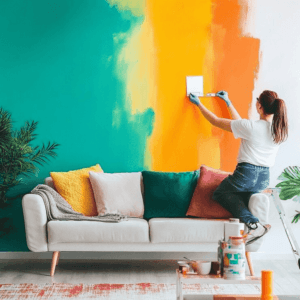Introduction to Latest Trends
The world of paint has undergone significant transformations in recent years, influenced by changing consumer preferences and advancements in technology. Today, the evolving landscape of paint trends showcases a clear shift towards sustainable and eco-friendly options. As awareness regarding environmental issues grows, consumers are increasingly seeking paints that minimize negative impacts on both health and nature. Manufacturers are responding by developing products that not only meet aesthetic needs but also align with ecological values, leading to an increase in the availability of low-VOC (volatile organic compounds) and water-based paints.
In addition to sustainability, the demand for innovative colors and finishes has become prominent. Traditional color palettes are giving way to bold and unexpected hues, reflecting a desire for individuality and self-expression in living spaces. Textured finishes, metallic glazes, and matte surfaces are also gaining traction as homeowners seek unique ways to enhance their environments. This trend is reshaping the conventional understanding of paint, transforming it from a mere protective coating to a vital element of interior design.
Another noteworthy aspect of the current paint trends is the reintegration of cultural art forms into contemporary design, with Mithila paintings being a prime example. Originating from the Mithila region of India, this traditional art style is characterized by intricate patterns and vibrant colors. Manufacturers are exploring ways to blend Mithila’s artistic heritage with modern paint formulations, creating unique products that celebrate cultural history while catering to modern aesthetics.
Overall, the trends in paint are indicative of a broader movement towards personal expression and social responsibility, setting the stage for a deeper exploration of specific innovations and the influence of artistic traditions in the industry’s evolution.
Sustainable and Eco-Friendly Paints
The demand for sustainable and eco-friendly paints has rapidly increased among both manufacturers and consumers in recent years. This shift towards environmentally responsible choices is largely driven by a growing awareness of the impact that traditional paints have on health and the environment. Among the most sought-after options are low-VOC (volatile organic compounds) and water-based paints, which represent a significant enhancement over their solvent-based counterparts. Low-VOC paints are designed to minimize harmful emissions during application and throughout their lifespan, making them a healthier choice for indoor air quality.
Mithila paints manufacturers are taking significant strides to incorporate these eco-friendly practices within their offerings. By focusing on natural ingredients and sourcing materials responsibly, they not only address the pressing needs of environmentally conscious consumers but also contribute positively to the ecosystem. Water-based paints are another alternative gaining traction; they tend to have lower harmful emissions and are easier to clean up compared to oil-based paints. This is particularly beneficial for residential spaces where air quality is paramount.
The use of sustainable materials ensures that the lifecycle of the paint itself aligns with environmentally friendly standards. As consumers become increasingly informed about the significance of eco-friendly products, Mithila paints manufacturers are innovating to provide solutions that meet both aesthetic and functional needs while reducing environmental footprint. Furthermore, the adoption of such sustainable practices not only enhances the reputation of manufacturers but also encourages more consumers to make responsible choices when it comes to home décor and maintenance products.
In conclusion, the rise of sustainable and eco-friendly paint options represents a pivotal shift in the industry, with Mithila paints manufacturers leading the way in implementing innovations aimed at protecting both health and the environment.

Innovative Color Trends
The paint industry is experiencing a dynamic evolution in color trends, with bold and vibrant hues gaining prominence alongside a rising preference for neutral palettes. As consumers seek to create environments that reflect their individuality and lifestyle, Mithila paints manufacturers are at the forefront of this transformation, skillfully blending traditional aesthetics with modern design elements.
Bold colors such as deep blues, fiery reds, and lush greens are increasingly becoming popular choices, enabling homeowners to make striking statements. These vibrant shades often evoke feelings of energy and creativity, making them suitable for accent walls or focal points within a space. Mithila paints manufacturers are leveraging these trends by offering innovative formulations that enhance color saturation and durability, ensuring that these vivid tones remain a long-lasting feature of contemporary interiors.
In contrast, the minimalist movement has prompted a surge in demand for neutral color palettes. Shades of soft beige, warm grays, and muted whites provide a canvas that promotes tranquility and sophistication. This growing inclination towards understated elegance allows homeowners to infuse their spaces with a sense of calm while providing the flexibility to incorporate bold decorative elements. Mithila paints manufacturers are adept at interpreting these neutral tones, creating formulations that resonate with the cultural nuances of traditional designs.
The influence of interior design shows and color forecasts plays a significant role in shaping consumer preferences. These platforms introduce new color combinations and innovative applications that challenge conventional aesthetics. By integrating traditional Mithila color schemes into current trends, manufacturers not only pay homage to their cultural roots but also enhance the artistic value of their products, thus enriching the overall consumer experience.

Textured and Unique Finishes
The realm of interior design has seen a notable shift towards textured paints and unique finishes, making them an essential consideration for homeowners and designers alike. These innovative techniques can elevate the aesthetic appeal of any space, turning plain surfaces into stunning focal points that reflect both personality and style. Various methods such as sponging, stenciling, and the application of metallic effects are becoming increasingly prevalent, allowing for a diverse range of visual textures and depth within interior environments.
Sponging, one of the most popular techniques, offers a soft, mottled appearance that can create a sense of warmth and depth. This technique employs a sponge to apply paint, resulting in an organic, textured look. Similarly, stenciling allows for the introduction of intricate patterns and designs, transforming walls into canvases that showcase both creativity and craftsmanship. Through careful placement of stencils, one can achieve a layered and sophisticated look that can range from elegant to bold, depending on individual preferences.
Another significant trend in textured painting involves the use of metallic effects. These finishes add a touch of luxury and sophistication to spaces, reflecting light and creating a dynamic interplay of tones. Metallic paints can be used on their own or in combination with other techniques to enhance visual interest, offering a modern take on classic aesthetics.
Mithila paints stand out in the industry due to their unique incorporation of intricate designs that reflect traditional Indian art. These manufacturers not only focus on visual appeal but also emphasize the craftsmanship behind their textured finishes. By merging contemporary techniques with ancient artistry, Mithila paints provide consumers with distinctive, high-quality finishes that honor cultural heritage while ensuring modern functionality in interior design.
Digital Innovation in Paint Manufacturing
In recent years, the paint manufacturing industry has undergone significant transformations driven by digital innovation. These advancements are not only enhancing production efficiency but also improving the quality and variety of products available. Among the notable trends, automation plays a crucial role in streamlining operations for manufacturers, including Mithila paints producers. By integrating robotic systems and intelligent machinery into the manufacturing process, companies can reduce human error, decrease labor costs, and maintain consistent product quality.
Another remarkable innovation in the field of paint manufacturing is color-matching technology. Utilizing advanced algorithms and machine learning techniques, these systems allow manufacturers to achieve highly accurate color formulations. As Mithila paints manufacturers rely on rich, vibrant colors inspired by traditional motifs, precise color matching has become essential. This technology not only accelerates the formulation process but also minimizes waste by ensuring that the exact amounts of pigments are used to achieve the desired hues.
Furthermore, virtual reality (VR) tools have emerged as an effective aid in paint selection for both manufacturers and consumers. These tools enable users to visualize how different colors and finishes will appear in various environments before making a purchase. For Mithila paints manufacturers, adopting VR technology can significantly enhance customer engagement and satisfaction. By allowing consumers to experience their products in a simulated space, manufacturers foster a better understanding of how their offerings align with customer preferences and interior design needs.
The integration of these digital innovations not only bolsters the operational capabilities of Mithila paints manufacturers but also plays a pivotal role in meeting the growing demand for customized solutions. In conclusion, the adoption of modern technologies in the paint manufacturing process is pivotal for the industry’s future, as these advancements enhance efficiency, quality, and customer experience.

Mithila Art: A Cultural Significance
Mithila art, originating from the Mithila region of Bihar, India, is a vibrant and intricate form of painting that holds deep cultural significance. Rooted in the ancient traditions of the region, these paintings, often executed on walls and floors, reflect not only the artistic skills of the local communities but also their beliefs, values, and social customs. The origin of Mithila art can be traced back to the 6th century, where it served as a form of storytelling, encapsulating the rich history and mythology of the land.
The intricate patterns and bright colors of Mithila paintings often depict scenes from Hindu scriptures, nature, and daily life, serving as a narrative that connects the viewer to the culture and spirituality of the community. The themes are not merely decorative; they convey profound meanings and serve as a medium through which artists express their emotions and experiences. Every motif, from the peacock to the lotus, carries symbolic significance, making each piece a unique representation of the artist’s worldview.
Mithila paints are traditionally created by skilled artisans, predominantly women, who have inherited these techniques through generations. This artistic practice is not just about creating visually appealing artwork; it is also an endeavor aimed at preserving cultural heritage. The painters utilize natural pigments and elaborate patterns, honoring the traditional methods while also adapting to contemporary tastes. In recent years, Mithila art has gained international acclaim, leading to a revival in interest and providing artists with opportunities to showcase their work on global platforms.
Thus, the role of Mithila artists extends beyond mere creation; they are custodians of culture. By continuing to produce Mithila paints, they preserve an important aspect of Indian heritage and contribute significantly to its recognition both nationally and internationally. In conclusion, Mithila art not only embodies beauty but is also a vital part of the cultural tapestry of India, linking past traditions with modern expressions.
Collaboration of Traditional and Modern Designs
In recent years, Mithila paints manufacturers have been actively exploring the synergy between traditional Mithila art and contemporary design elements. This collaboration manifests as a fusion that captures the essence of cultural heritage while appealing to modern aesthetic preferences. By incorporating innovative techniques and design principles, these manufacturers are effectively bridging the gap between the rich history of Mithila art and the demands of today’s consumers.
One significant aspect of this collaboration is the adaptation of traditional motifs and themes to suit contemporary home decor requirements. Mithila artists are now experimenting with color palettes, materials, and forms that resonate with modern sensibilities. For instance, while traditional Mithila paintings often utilized vivid natural colors sourced from plants and minerals, current trends have seen artists adopting more subdued tones or even monochromatic schemes to align with minimalist decor styles. This blend ensures that the artwork remains culturally significant while also being visually appealing in modern settings.
Additionally, Mithila paints manufacturers are embracing digital technology to expand their reach. They are utilizing advanced printing methods that allow for the reproduction of traditional art on various substrates, such as canvas, wood, and even textiles. This not only enhances the accessibility of Mithila art but also provides an opportunity to integrate traditional designs into modern fashion and interior design marketplaces. Collaborative efforts with designers and artists from diverse fields have also led to the creation of unique products that celebrate this cultural art form, making it relevant for a global audience.
In conclusion, the collaboration between traditional Mithila art and contemporary design elements presents a promising avenue for growth and innovation within the industry. By balancing cultural authenticity with modern aesthetics, Mithila paints manufacturers are paving the way for the future of this rich art form, ensuring its preservation and appreciation in an ever-evolving world.
Market Demand and Economic Impact on Manufacturers
The demand for various types of paint, including specialty products like Mithila paints, has seen a notable increase in recent years. Factors driving this demand include shifting consumer preferences towards unique and traditional art forms, along with a growing appreciation for cultural artifacts in home décor. Mithila paints, characterized by their intricate patterns and vibrant colors, appeal not only to those interested in traditional Indian art but also to consumers looking to add a unique touch to their living spaces. The market for these specialized paints corresponds with a broader trend where consumers favor personalized and meaningful artistic expressions in their purchasing decisions.
The economic implications of this rising demand are substantial for manufacturers. As more consumers seek Mithila paints, manufacturers must adapt by enhancing production capabilities to meet diverse customer needs. This includes investing in quality raw materials, refining production processes, and training artists proficient in this traditional craft. Additionally, the economic impact extends to local artists and artisans who participate in the production of Mithila paints, providing them with sustainable livelihoods and opportunities to showcase their skills in a competitive market.
Moreover, pricing strategies play a pivotal role in market dynamics. While general paint products may experience more price elasticity, Mithila paints often command a premium due to their artistic nature and cultural significance. Distributors and retailers also contribute to the economic landscape, creating pathways for these products to reach a wider audience. The rise of e-commerce platforms has further facilitated access to Mithila paints, allowing manufacturers to bridge the gap between rural artisans and urban consumers.
In conclusion, the combined shifts in market demand and economic strategies have positioned Mithila paint manufacturers to thrive. These changes not only benefit the producers but also foster greater appreciation for traditional art forms in contemporary settings.

Future Directions: Emerging Trends to Watch
The realm of paint, particularly Mithila paints, is poised for transformation as we observe evolving consumer preferences and technological innovations. As sustainability becomes a priority across various industries, it is likely that Mithila paints manufacturers will adapt their practices to align with eco-friendly standards. This shift could involve the use of natural pigments and organic materials, which not only resonate with environmentally conscious consumers but also enhance the authenticity of the Mithila art form. The trend towards sustainability is not just beneficial for the planet; it also caters to a market that increasingly favors products that contribute positively to environmental preservation.
Furthermore, the integration of technology in the creation and distribution of Mithila artworks is expected to rise. With advancements in digital printing technologies, artists can experiment with designs more extensively and reach a broader audience. The use of augmented reality (AR) applications may also become a common tool in the market, allowing consumers to visualize how Mithila paintings would appear in their own spaces, thus making informed purchasing decisions.
Aesthetically, there seems to be a growing inclination among consumers towards fusion art forms. This may lead to innovative blends of traditional Mithila motifs with contemporary artistic expressions, appealing to a younger, more diverse audience. Manufacturers may find success by showcasing this adaptability, ultimately positioning Mithila paints as relevant in a global art market. As individual tastes continue to diversify, the potential for cross-cultural collaborations is immense, encouraging artists to experiment with new themes that resonate with an international audience.
As we look ahead, it is crucial for both artists and manufacturers to remain responsive to these changes. By embracing sustainability, technology, and creative experimentation, the future of Mithila paints holds exciting possibilities. Keeping an eye on these trends will provide valuable insight into how Mithila artistry will continue to evolve and thrive in the modern landscape.

